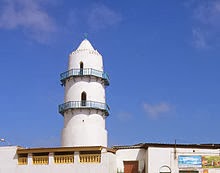I am so excited to study Djibouti this week. It is a country I know very little of. Djibouti is in northeast
Africa, on the Red Sea coast, bordered by Eritrea, Ethiopia, and Somalia. The
country was created by France in the late nineteenth century during the
colonial scramble for Africa. In 1977, it became independent after having been
a protectorate and colony for more than a century.
The Culture of Djibouti is very rich and diverse. Arabs, French, Somalis, and other minority groups make up the ethnicity of Djibouti. The people of Djibouti are known to be very hospitable, kind, and generous. These different ethnic groups living in Djibouti have coexisted and been in harmony for years by respecting each other's traditions and actively participating in the various cultural festivities. How wonderful is that!
The Culture of Djibouti is very rich and diverse. Arabs, French, Somalis, and other minority groups make up the ethnicity of Djibouti. The people of Djibouti are known to be very hospitable, kind, and generous. These different ethnic groups living in Djibouti have coexisted and been in harmony for years by respecting each other's traditions and actively participating in the various cultural festivities. How wonderful is that!
There are generally two major
ethnic groups in Djibouti, the Issa-Somali and the
Afar. These groups have had minimal conflict and are known to possess a shared identity
and national consciousness as well as cultural
similarities. The
coat of arms shows two bent olive branches within which a traditional round
shield is pictured over a vertical Somali spear topped with a red star and
flanked by two Afar daggers to the left and right. It symbolizes the ideal of
coexistence of the two dominant communities. The flag is a tricolor with blue,
white, and green fields and a red star on the triangular white field on the
left.
In Djibouti, 95 percent of the people practice Islam. The most popular and holy place for the Muslims in the country is in the Goda Mountains where the tomb of Sheikh Abu Yazid is present. This is an integral part of the custom of Djibouti. The only Djibouti Holiday that falls in the category of non-Muslim holiday is that of Christmas, which is celebrated in the country with glory. The religions of Djibouti also consist of minorities in Orthodox Greek and Protestant. Roman Catholicism is also practiced in Djibouti. In Djibouti, there is no state religion and the political parties do not support or oppose any particular religion.
The women of Djibouti wear long skirts and cover their faces with a veil. The married women also cover their head with cloth. During the religious festivals, people always stick to the traditional dress. The art and culture of the country is mostly passed on locally from one generation after generation. The local people dance, sing and also act for a particular story in their native language.

The influence of French and Islam tradition and culture can be witnessed in the architecture of the buildings of Djibouti. The art works in the houses of Djibouti people include various forms of calligraphy, plasterwork and motifs. The Afar group also has stylish literature which is mainly verbal and the major part of the literature is preserved in the form of songs. Songs in Djibouti are usually classified into various groups such as praise songs, war songs and many more.

The major Djibouti language that is spoken in the country is that of French and Arabic. The chief traditional languages that are spoken by the inhabitants of the country are Issa-Somali and Afar. The languages of Issa-Somali and Afar are the incorporations of the Cushitic language group.
Somali language is also spoken by a large number of people. The language of Afar is also limited to the areas of Afar people. There are so many languages of Djibouti that most of the residents of the country are multi lingual. Other languages that are spoken in Djibouti are Arabic and Taizzi-Adeni.
In schools, French is the official language of study. The cuisine of Djibouti is highly influenced by the French and the Arab culinary art forms.









No comments:
Post a Comment